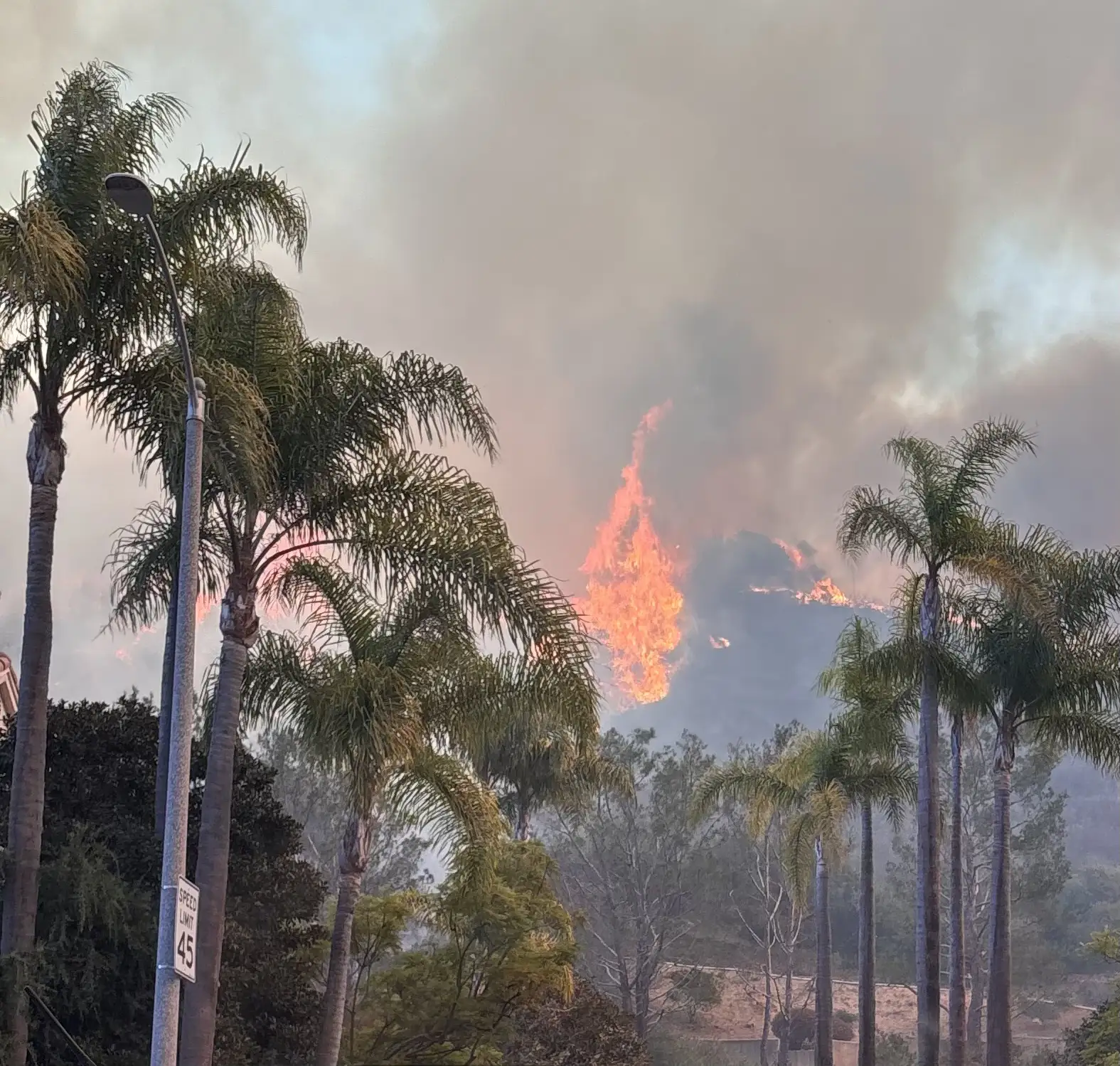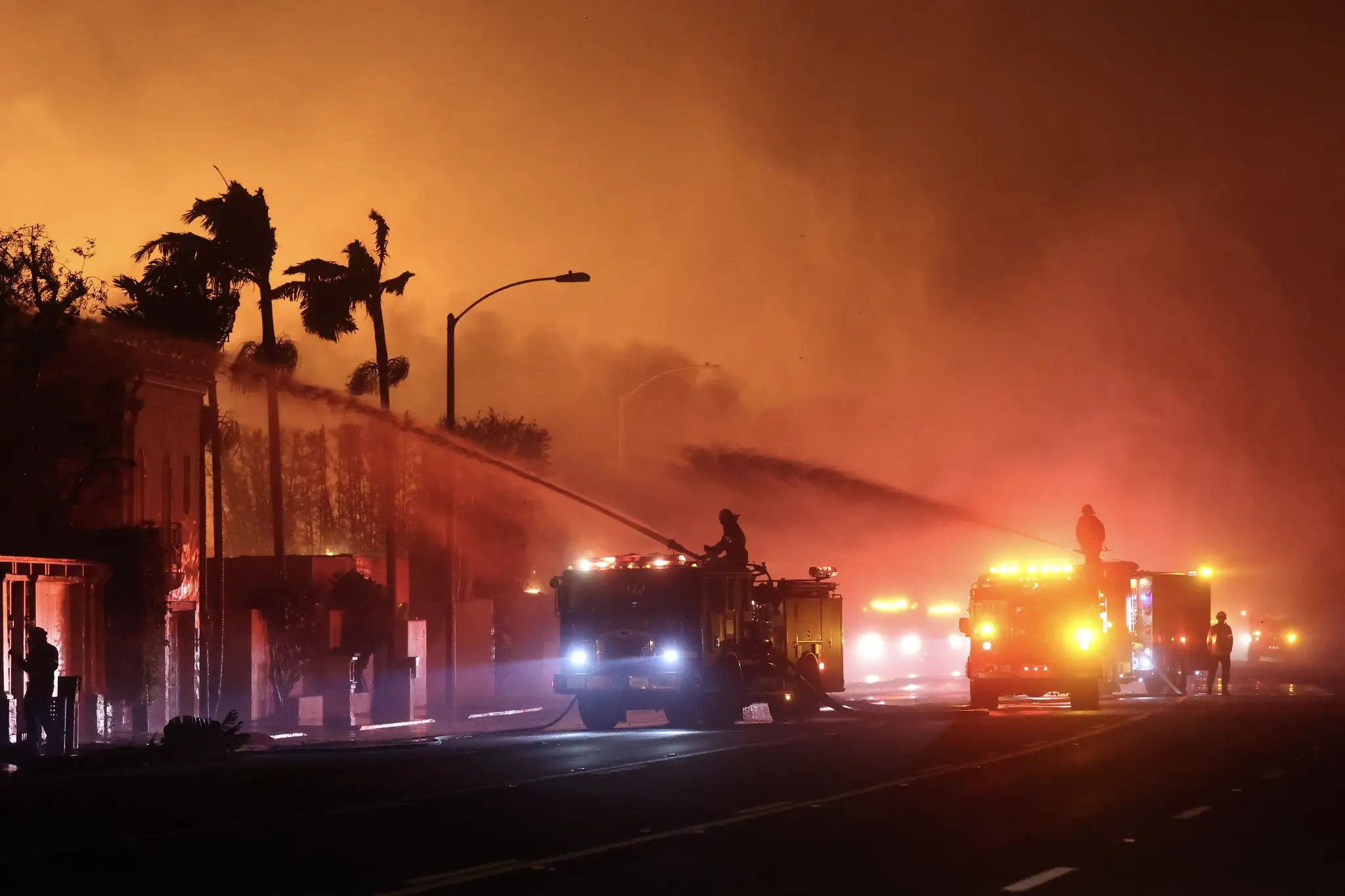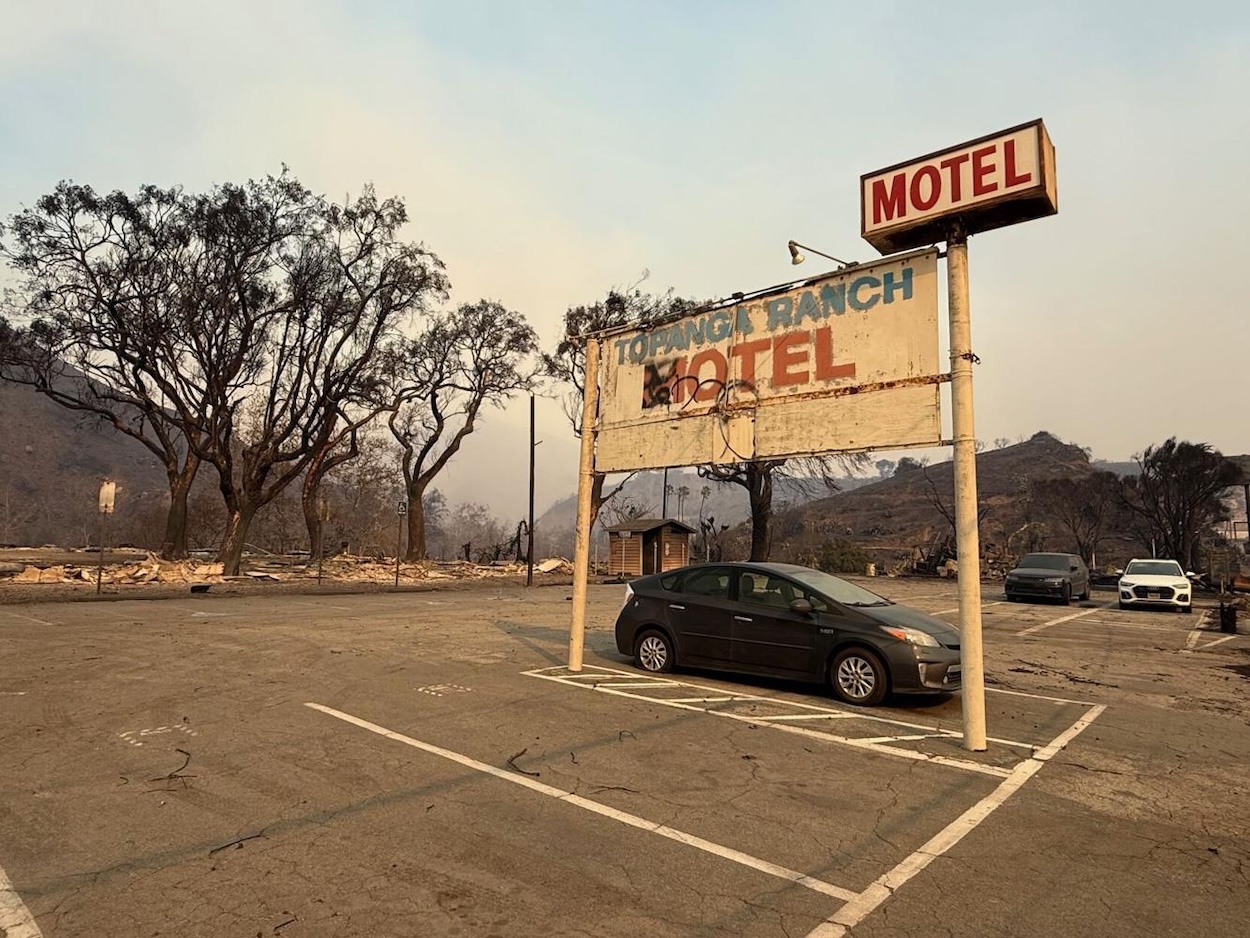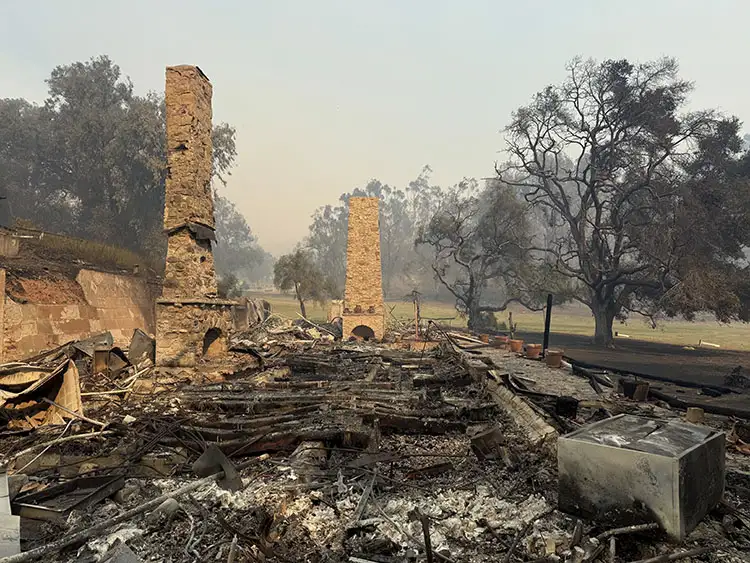The Losses are Profound as Los Angeles is Ravaged by Fire and Wind
.jpg?1736660950)
The Palisades fire viewed from the shoreline. Photo by CAL FIRE/Flickr via Wikimedia Commons. Public Domain
This article, first published on January 8, was last updated on January 13 to include additional threatened and destroyed sites as well as the latest figures from CAL FIRE regarding the size of the main wildfires impacting Los Angeles and the number of fatalities.
At 11:00 a.m. Pacific Time on January 8, the Santa Ana winds still howl across Los Angeles as the city grapples with an unprecedented wildfire event spurred by hurricane-strength gusts and bone-dry conditions.
First reported 24 hours earlier as a small brush fire in the mountains above the affluent, close-knit coastal enclave of Pacific Palisades, the blaze quickly engulfed the large swaths of the region’s precarious wildland-urban interface. There are now a trio of major active wildfires raging in and around Los Angeles County: the Palisades fire, has grown to nearly 24,000 acres and spread to western neighbor Malibu and threatened parts of Brentwood and Santa Monica to the east and southwest, respectively; the deadly Eaton fire, located north of Pasadena in the foothills of the San Gabriel Mountains, has destroyed more than 14,000 acres; and the Hurst fire near Sylmar, in the far north of the San Fernando Valley, has claimed nearly 800 acres. Per the latest data from the California Department of Forestry and Fire Protection (CAL FIRE), the Palisades and Eaton fires are currently below 40 percent containment and new blazes have also erupted across the region, including in the Hollywood Hills and north of Calabasas. At least 23 deaths have been reported.

The Palisades fire as seen from Pacific Palisades. Photo by Ariam23, Wikimedia Commons
A vast number of homes, businesses, and civic buildings—including schools, libraries, and reportedly, the Pacific Palisades fire station—have been torched and tens of thousands of Angelenos have evacuated from the impacted areas. The scene is nothing short of apocalyptic, the loss immeasurable.
Although the estimated number of destroyed structures surpasses 12,000, the total scope of devastation won’t be fully known until the winds calm and the smoke clears. Below is a running list of culturally and historically significant structures and local landmarks impacted, many of them total losses, by the catastrophe. This list will be updated as more information becomes available.
The Getty Villa
While parts of its grounds were set ablaze on January 7 as the Palisades fire first exploded, the famed museum’s buildings and renowned collection of Greek, Roman, and Etruscan antiquities were spared during that outbreak. Still, the Getty Villa and the Richard Meier–designed Getty Center in Brentwood, which together comprise the J. Paul Getty Museum, remain under active threat and are both closed until at least January 16. “Some trees and vegetation on site have burned, but no structures are on fire, and staff and the collection remain safe,” confirmed the museum in an update published on social media on the evening of January 7. First opened in 1974, the Getty Villa’s immersive campus was modeled after the Villa of the Papyri at Herculaneum by L.A. architects Robert E. Langdon, Jr. and Ernest C. Wilson Jr. An expansive, critically lauded campus revamp led by Machado Silvetti was completed in 2006.

First responders on the scene in Pacific Palisades. Photo by CAL FIRE/Flickr; Public Domain
The Eames House
Like the Getty Villa, another cherished cultural site in Pacific Palisades, Charles and Ray Eames’ Case Study House No. 8, appears to be safe for now. In an update published on Instagram the morning of January 8, the Eames Foundation wrote that the 1949 studio-residence was “unharmed by the wildfires … but the windblown fires continue to claim other homes in the community and bring the fires nearer.” The foundation adds that it is closely monitoring the situation and that a small number of objects were removed from the property by staff prior to mandatory evacuation orders. “The loss and displacement caused by these fires is staggering, and we stand in solidarity with everyone affected during this incredibly difficult time.” All public tours and visits to the National Historic Landmark–listed house museum have been suspended.
Case Study Houses
In addition to the Eames House, Pacific Palisades is home to several other surviving residences commissioned in the late 1940s and early 50s as part of Arts & Architecture magazine’s experimental Case Study Houses program. There is currently no information regarding Case Study Houses No. 9 (Entenza House, Charles Eames and Eero Saarinen), No. 18A (West House, Rodney Walker), or No. 20A (Bailey House, Richard Neutra) along with Case Study Houses outside of Pacific Palisades in other wildfire-impacted areas such as Pasadena, Altadena, and La Cañada Flintridge.
Freedman House
While no Richard Neutra-designed Case Study Houses have been reported as lost to the wildfires, one of the Vienna-born visionary Modernist’s other L.A. dwellings has been confirmed as destroyed by the Los Angeles Conservancy: Located at 315 Via de la Paz in Pacific Palisades, the Benedict and Nancy Freedman House was completed in 1949 and extensively renovated in 2014.
Andrew McNally House
Added to the National Register of Historic Places in 2007, this grand Queen Anne-style house in Altadena was designed by Frederick Roehrig for Irish-born map publishing tycoon Andrew McNally. Completed in 1887 and extensively restored over the years, including in the 1950s, the mansion was consumed by the Eaton fire.

The historic Topanga Ranch Motel was destroyed along with neighboring businesses on the Pacific Coast Highway. Photo courtesy California State Parks
The Topanga Ranch Motel
Although abandoned for years, this bungalow-style motor court along the Pacific Coast Highway (PCH) on the eastern edge of Malibu was a local landmark that had appeared in numerous movies and television shows. Built by William Randolph Hearst in the 1920s to house workers constructing the PCH, the property was on the cusp of a major restoration project that would have ultimately seen it reopen to visitors. Sadly, it was lost in the Palisade fire along with nearby businesses flanking the PCH, including long-running roadside seafood institution the Reel Inn, located next door.
Will Rogers State Historic Park
California State Parks has reported that the 31-room former ranch house of vaudeville performer-turned-early Hollywood star, the Oklahoma-born “cowboy philosopher” Will Rogers, was leveled by fire along with other buildings—including multiple historic structures and park employee residences—located within the state park in Pacific Palisades bearing his name. In total, California State Parks estimates that there were 30 structural losses between Will Rogers State Historic Park and neighboring Topanga State Park.

The remains of actor and humorist Will Rogers’ former ranch house at Will Rogers State Historic Park in Pacific Palisades. Photo courtesy California State Parks
Corpus Christi Catholic Church
Completed in 1964, this midcentury church on Toyopa Drive in Pacific Palisades designed by noted L.A. architect Albert C. Martin (of Los Angeles City Hall and May Company Building fame) was destroyed by fire. Only the building frame remains standing. As noted by the city’s Historic Resources Inventory, the church was an “excellent example of New Formalist institutional architecture.” Another significant church in the neighborhood, the Charles Moore–designed St Matthew's Episcopal Church (1983), has not reported damage at the time of publication.
Pasadena Jewish Temple and Center
This Conservative synagogue, housed in a historic Mission Revival-Style building on Pasadena’s North Altadena Drive since 1945, was destroyed in the Eaton fire. As reported by NBC4 Los Angeles, the Torah scrolls were safely removed during the evacuation process and are in safekeeping at the home of a congregant.
Keeler House
The Keeler House (1991) in Pacific Palisades, considered to be one of late architect and SCI-Arc founder Ray Kappe’s finest works, has been deemed a total loss. The daringly cantilevered post-and-beam dwelling received renewed attention when it hit the market last spring for $12 million. Writes Crosby Doe Associates, a real estate group specializing in historic and architecturally significant properties: “The ongoing Los Angeles County fires are a devastating reminder of how fragile our built heritage can be. Among the losses are many iconic homes that stood as testaments to the artistry and vision of their creators, and the irreplaceable lifestyles they afforded their owners.” RECORD is awaiting confirmation that Kappe’s own Palisades home, completed in 1967 and designated a Los Angeles Historic-Cultural Monument in 1996, was spared by the firestorm.
Villa Aurora and Thomas Mann House
Villa Aurora and the Thomas Mann House in Pacific Palisades—the former is a restored 1920s-era Spanish Colonial Revival-style estate hosting artist residencies and the latter is a 1941 Modernist house designed by Julius Ralph Davidson that has been used as a “space transatlantic debate” since 2018—have both, as of January 9, been spared from destruction. Writes the Berlin and L.A.-based institution that operates both sites: “There are first indications that parts of Villa Aurora were able to withstand the destructive fires. A comprehensive evaluation of the damage remains yet to be done, so that we are currently unable to make a final assessment of the damage to the building, the historic furnishings, and the library. The Thomas Mann House is undamaged so far. This too is a momentary snapshot, as the situation can change any time: The building continues to be in the danger and evacuation zone.”
Zane Grey Estate
When it was completed in 1907, this Mediterranean Revival manse built from reinforced concrete was touted as the first fireproof home in Altadena—sadly, it was no match for the Eaton fire. Designed by Myron Hunt and Elmer Grey for Chicago business magnate Arthur H. Woodward, the house was purchased by popular fiction author Zane Grey in 1920, who expanded the already-sprawling property. It was added to the National Register of Historic Places in 2002, last going up for sale in 2020.
Park Planned Homes
This 28-house tract in Altadena dating back to the late 1940s was conceived by architect and social housing pioneer Gregory Ain with landscape architect Garrett Eckbo as one of the first Modernist housing developments in the United States. Multiple homes were lost to the Eaton fire.
Scripps Hall
Neighboring Park Planned Homes was the also-destroyed Machris Mariposa Campus of Pasadena Waldorf School. Among the buildings lost was the school’s historic anchor, a 1904 Arts and Crafts style mansion known as Scripps Hall. Designed by Charles W. Buchanan, the National Register of Historic Places–listed house was the centerpiece of the former Scripps Estate, partially acquired by the Waldorf School in 1979.
Robert Bridges House
The subject of a 2014 New York Times profile, this dramatic, difficult-to-miss home was perched above Sunset Boulevard on thick concrete pillars. It was lost to the Palisades fire as it tore through the Rustic Canyon neighborhood near Will Rogers State Historic Park.
For those seeking to help people and animals affected and displaced by the L.A. wildfires, the Los Angeles Times has published a comprehensive list of charitable organizations worth considering.




